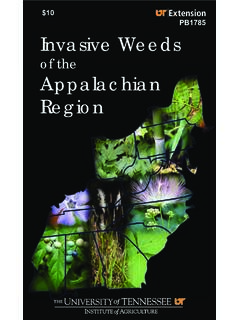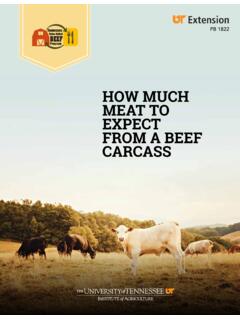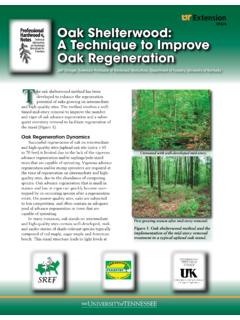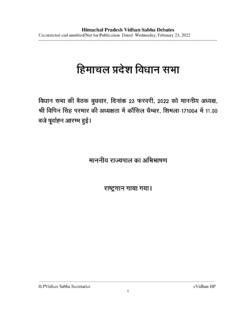Transcription of Table 1. Fruit and vegetable storage conditions and shelf ...
1 storage of Fresh ProduceStorage of Fresh ProduceStoring produce at the proper temperature is critical to obtaining the longest shelf -life. Table 1 provides the optimal storage temperature and shelf -life for each commodity. If a crop is stored at higher than ideal temperatures, the shelf -life will be reduced. Similarly, if a crop is stored at a lower than ideal temperature, freezing or chilling injury could compromise the 1. Fruit and vegetable storage conditions and storage Temperature ( F) shelf -Life at Ideal storage TemperatureApples30-401-12 monthsAsparagus32-352-3 weeksBeans, Butter/Lima37-415-7 daysBeans, Snap40-457-10 daysBeets, Topped324-6 monthsBlackberries31-322-3 daysBlueberries31-321-2 weeksBoysenberries31-322-3 daysBroccoli3210-14 daysBrussels sprouts323-5 weeksCabbage323-6 weeksCantaloupe32-365-14 daysCarrots, Mature327-9 monthsCauliflower323-4 weeksCelery322-3 monthsCherries30-312-3 weeksCollards3210-14 daysCorn325-8 daysCucumbers50-5510-14 daysEggplant46-541 weekGrapes31-32 2-8 weeksKale322-3 weeksLettuce322-3 weeksMustard3210-14 daysOkra45-507-10 daysOnions, Green323-4 weeksOnions, White321-8 monthsParsnips324-6 monthsPeaches31-322-4 weeksPears29-312-7 monthsPeas, English321-2 weeksPeas, Southern40-416-8 daysPeppers.
2 Bell45-55 2-3 weeksPlums31-322-5 weeksPotatoes, Irish404-5 monthsPotatoes, Sweet55-604-7 monthsThis project was supported all, or in part, by a grant from the National Institute of Food and Agriculture, United States Department of Agriculture (Award Number 2009-51110-20161) and a Tennessee Specialty Crop Block Grant (32506-09813).Publication #FDNS-E-168-27. Harrison, Critzer and Wszelaki. February 2015. SP 768-FThe University of Georgia and Ft. Valley State University, the Department of Agriculture and counties of the state cooperating. Cooperative Extension, the University of Georgia Colleges of Agricultural and Environmental Sciences and Family and Consumer Sciences, offers educational programs, assistance and materials to all people without regard to race, color, national origin, age, gender or disability.
3 An Equal Opportunity Employer/Affirmative Action Organization, Committed to a Diverse Work storage Temperature ( F) shelf -life at Ideal storage TemperaturePumpkins50-552-3 monthsRadish323-4 weeksRaspberries31-322-3 daysRhubarb322-4 weeksRutabaga324-6 monthsSpinach3210-14 daysSquash, Summer41-501-2 weeksSquash, Winter50-552-6 monthsStrawberries325-7 daysTomatoes, Ripe46-504-7 daysTomatoes, Cherry47-504-7 daysTurnips324-5 monthsWatermelon50-602-3 weeksGroup 1. Temperature 32-36 F, Relative Humidity 90-95%Apples*BerriesGrapesPears*Rutabaga sAsian pears*Cantaloupe*ParsnipsPlums*TurnipsBe ets, toppedCherriesPeaches*Radishes*These items can produce high levels of ethylene that can be detrimental to items in Group 2. Temperature 32-36 F, Relative Humidity 90-95%Beets, toppedCabbageCherriesGreensRadishesBerri esCarrotsCornLettuceRhubarbBroccoliCauli flowerGrapesParsnipsRutabagasBrussels sproutsCeleryOnions, GreenPeasTurnipsGroup 3.
4 Temperature 32-36 F, Relative Humidity 65-75%GarlicOnionsShallotsGroup 4. Temperature 50 F, Relative Humidity 90-95%Beans EggplantPeppersSquash, SummerTomatoes, RipeCucumbersOkraPotatoes Squash, WinterWatermelon Fifty degrees is slightly above ideal conditions for these Hardenburg et al., 1986. The Commercial storage of Fruits, Vegetables, and Florist and Nursery stocks . Department of Agriculture, Agriculture Handbook No. 66 (revised) 130 from Boyhan et al., 2009. Postharvest Handling and Transportation of Fruits and Vegetables. The University of Georgia Cooperative Extension Fact Sheet 100. 4 times, even when crops have the same ideal storage temperature, they should not be stored together. Some crops (mainly true fruits) produce high levels of ethylene, the ripening hormone.
5 Ethylene can compromise the quality and reduce the shelf -life of crops by causing bitterness, softening, discoloration and stem detachment. Moreover, onions and peppers can impart off-flavors to apples and potatoes, if they are stored together. Commodities also differ in ideal relative humidity conditions . Most fruits and vegetables are composed of more than 80 percent water; therefore, the higher the relative humidity in the air surrounding the commodity during storage , the longer the shelf -life. The ideal relative humidity for the majority of fruits and vegetables is 90-95 percent; however, root crops, like onions and garlic, will be damaged and decay more quickly at high humidity and should be stored at 65-75 percent relative humidity, if possible.
6 Table 2 shows crop storage 2. storage compatibility.











